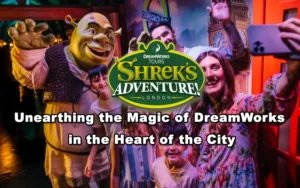Located in the core of London, the London Borough of Lambeth offers a mesmerizing fusion of historical landmarks and contemporary urban spaces. With a tapestry of varied communities, Lambeth stands as a testament to London’s rich and layered character.
From its agrarian origins symbolized by its name’s etymology to its present-day role as a cultural and residential epicentre, this borough epitomizes the city’s evolution and vibrancy. Dive into the rich tapestry of Lambeth and discover how it weaves history, culture, and urban vitality into a compelling narrative of London’s essence.
- The Historical Essence of the London Borough of Lambeth
- Lambeth Palace: An Enduring Symbol of Church and History
- The Southbank Centre: London’s Cultural Heartbeat
- The London Eye: An Iconic View of the Capital
- Brixton Market: A Melting Pot of Cultures and Flavours
- Brixton Town Hall: A Pillar of Local Governance and Heritage
- Clapham Common: London’s Green Oasis in the Heart of the City
- Brockwell Park: A Green Oasis in South London
- The Oval: A Temple of Cricket in London’s Heart
- The Garden Museum: Celebrating Britain’s Horticultural Heritage
- Waterloo Station: The Gateway to London
- Lambeth Bridge: Linking History and Boroughs
- Vauxhall Bridge: An Emblem of London’s Artistic and Engineering Heritage
- The Undying Spirit of the London Borough of Lambeth
- A Melting Pot of Cultures in London Borough of Lambeth
- Summing Up London Borough of Lambeth
The Historical Essence of the London Borough of Lambeth
The name “Lambeth” can be traced back to its ancient roots, signifying the ‘landing place for lambs’. Its history is dotted with Roman settlements, Medieval establishments, and Victorian era developments. Over the centuries, the borough has seamlessly transformed, while holding onto its historical essence, offering a delightful blend for the history enthusiast.
Lambeth Palace: An Enduring Symbol of Church and History
Lambeth Palace, situated on the River Thames’ south bank, has been the Archbishop of Canterbury’s official residence for over 800 years. As a significant site for the Church of England, it blends various architectural styles from different eras. Notable structures include the 17th-century Great Hall, which houses a vast collection of religious texts; the 15th-century Lollards’ Tower, linked to early religious reformers; and a stunning Gothic chapel from 1248.
Beyond its historic and religious importance, the palace boasts expansive gardens that provide a peaceful oasis in urban London. Overall, Lambeth Palace is a living testament to England’s rich religious history and architectural heritage.
The Southbank Centre: London’s Cultural Heartbeat
The Southbank Centre, located on London’s vibrant South Bank, is a prominent cultural hub originating from the 1951 Festival of Britain. The complex boasts several venues, including the acoustically renowned Royal Festival Hall, the refurbished Queen Elizabeth Hall and Purcell Room for more intimate performances, and The Hayward Gallery, known for contemporary art exhibitions.
Serving as a focal point in London’s arts scene, the centre offers diverse programming and emphasizes inclusivity and accessibility. Beyond its walls, the surrounding South Bank area provides a range of attractions, ensuring the Southbank Centre remains central to London’s cultural heartbeat.
The London Eye: An Iconic View of the Capital
The London Eye, once called the Millennium Wheel, stands as a modern icon along the River Thames. Designed by Marks Barfield Architects to commemorate the year 2000, this 135-meter tall observation wheel offers visitors a 360-degree panoramic view of London’s iconic landmarks. With 32 air-conditioned capsules, it provides a leisurely 30-minute rotation, allowing guests to marvel at sights like Big Ben and Buckingham Palace.
Beyond being a popular attraction, the Eye holds cultural significance, hosting events like New Year’s Eve fireworks. Its blend of innovative design and engineering earned acclaim from architectural bodies. Today, the London Eye is a symbol of London’s fusion of historic charm and modern evolution.
Brixton Market: A Melting Pot of Cultures and Flavours
Brixton Market, located in South London, is a vibrant representation of the city’s multicultural essence. Originating in the 1870s, it has grown alongside Brixton’s diverse immigrant communities, especially the mid-20th-century Caribbean influx. The market is divided into an open-air street section, selling everything from fresh produce to textiles, and the covered Brixton Village and Market Row, renowned for their global cuisines and boutique shops.
Over the years, the introduction of trendy establishments has sparked discussions about gentrification. Beyond shopping, the market offers a cultural immersion with its rich blend of music, food, and traditions. It stands as a testament to London’s rich cultural tapestry.
Brixton Town Hall: A Pillar of Local Governance and Heritage
Brixton Town Hall, situated in South London’s lively Brixton area, is a historic symbol of the community’s development from the late 19th century onwards. Boasting an Edwardian Baroque design, this building has been at the heart of local governance and has hosted numerous cultural and social events.
While its exterior has been preserved to reflect its original charm, the interiors have been updated for modern utility. Today, beyond its administrative functions, it remains a dynamic hub for community events, epitomizing Brixton’s rich heritage and vibrant spirit.
Clapham Common: London’s Green Oasis in the Heart of the City
Clapham Common, covering about 220 acres in London, is a beloved green space with a rich history, dating back centuries. Originally used for grazing, it became a public park in the mid-19th century. Home to diverse wildlife, including various bird species, the Common also boasts mature trees and plant life. Visitors can engage in numerous activities, from sports to music events at the historic Victorian bandstand.
While the park frequently hosts events and festivals, conservation efforts ensure its natural beauty is preserved for future generations. In essence, Clapham Common is a cherished blend of urban recreation and natural tranquility in London.
Brockwell Park: A Green Oasis in South London
Brockwell Park, located in Lambeth, is a 125-acre urban oasis with a history dating back to the 19th century. Originally part of the Brockwell Hall estate, it offers visitors a blend of historical charm and modern amenities. Highlights include the Art Deco-styled Brockwell Lido, serene Walled Garden, diverse sports facilities, and dedicated children’s play areas.
The park is also a hub for events, hosting various festivals and community fairs throughout the year. Rich in flora and fauna, Brockwell supports a range of wildlife, especially around its pond. Community groups actively engage in its upkeep and event organization, ensuring the park remains a beloved spot in South London.
The Oval: A Temple of Cricket in London’s Heart
The Oval, located in Kennington, South London, is a historic cricket ground established in 1845 by the Surrey County Cricket Club. Recognized for its unique shape and iconic gas holders, it has hosted numerous significant matches, including the first-ever Test in England in 1880 and the inception of The Ashes rivalry in 1882.
While primarily a cricket venue, The Oval has also been a stage for football, rugby, concerts, and community events. As the home ground for Surrey County Cricket Club, it continues to be a central venue for both international and domestic matches, symbolizing London’s sporting and cultural heritage.
The Garden Museum: Celebrating Britain’s Horticultural Heritage
The Garden Museum in Lambeth, situated in the former St Mary-at-Lambeth Church, is the world’s first museum dedicated to gardening. It was established in the 1970s after the discovery of the tombs of 17th-century royal gardeners, John Tradescant the Elder and his son. The museum showcases the evolution of British gardening through various exhibits, including tools and artworks.
A highlight is the Sackler Garden, designed by Dan Pearson. After significant renovations in 2017, the museum expanded its spaces, blending historical architecture with modern design. The institution actively engages with the community through events like the Garden Literary Festival and offers educational workshops and courses. It stands as a tribute to Britain’s deep-rooted gardening heritage.
Waterloo Station: The Gateway to London
Waterloo Station, close to London’s River Thames and started in 1848, is now the UK’s top train station with around 100 million people passing through yearly. Plus, it was a key spot for moving soldiers and supplies during the World Wars. The station today offers 24 platforms, serving both regional and suburban areas, and includes numerous shops, restaurants, and cafés for travellers.
For a period, it also hosted Eurostar services to Europe. Waterloo’s cultural impact extends to cinema and literature, with the nearby BFI London IMAX cinema being a significant cultural spot. As London continues to grow, plans are underway to further expand and upgrade the station.
Lambeth Bridge: Linking History and Boroughs
Lambeth Bridge, spanning the River Thames, connects London’s boroughs of Lambeth and Westminster. Its roots trace back to a medieval horse ferry, but the modern bridge, known for its red colour, opened in 1932. This shade is thought to represent the House of Lords, contrasting with the green of the nearby Westminster Bridge.
The bridge boasts Art Deco design elements and is adorned with obelisks featuring pinecone-like structures. Positioned near landmarks like the Palace of Westminster, it’s vital for traffic and has a strong cultural presence in films and literature. Recent upgrades have enhanced its safety and durability.
Vauxhall Bridge: An Emblem of London’s Artistic and Engineering Heritage
Vauxhall Bridge, stretching over the River Thames, links Vauxhall in Lambeth to Pimlico in Westminster. While an early version opened in 1816, the current bridge, designed by engineers Alexander Binnie and Maurice Fitzmaurice, was established in 1906.
A standout feature is its eight bronze statues symbolizing the Arts and Sciences, crafted by renowned sculptors Frederick Pomeroy and Alfred Drury. Today, the bridge is vital for London’s traffic and has made appearances in various art forms. It underwent refurbishments to preserve its historical and functional essence, showcasing London’s knack for marrying utility with beauty.
The Undying Spirit of the London Borough of Lambeth
Lambeth’s true essence lies not just in its landmarks but in its streets, alleys, and the stories of its people. The borough has seen times of turbulence, notably during World War II when it was heavily bombed, yet has always risen, rebuilding and renewing itself.
Events like the Lambeth Country Show, a blend of traditional rural and urban arts, encapsulate the borough’s spirit, demonstrating its capacity to evolve while staying true to its roots.
A Melting Pot of Cultures in London Borough of Lambeth
The London Borough of Lambeth is celebrated for its cultural diversity. Over the years, waves of immigrants have made Lambeth their home, each community adding a distinct flavour to its cultural potpourri. This is evident in the borough’s eateries, markets, festivals, and even its street art.
Summing Up London Borough of Lambeth
Lambeth, nestled in the heart of London, stands as a testament to the city’s rich tapestry of history, culture, and continuous evolution. Reflecting the broader dynamism of London, the borough beautifully merges its past — with landmarks like Lambeth Palace — with a present marked by cultural hubs like the Southbank Centre and the lively streets of Brixton.
With its vibrant mix of communities and forward-thinking initiatives, Lambeth embodies the multifaceted allure of London, making it a captivating destination for both its inhabitants and those who visit.
“I may earn commissions as an affiliate from sponsored links within this post”






